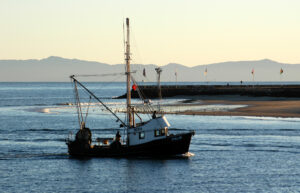Where the commons has been at least partly privatized there is less damage to fish stocks, the fishing is safer, and fewer resources are needed to achieve a given harvest.
Fisheries provide the classic example of the tragedy of the commons, which occurs when property rights are incomplete and access to a resource is open. The migratory nature of most fish species makes it difficult to establish and protect rights to fish in the sea, so the rule of capture prevails. The result is often overexploitation of the resource. Economists long have argued that the waste associated with this problem could be reduced if we “privatized the commons,” that is, created individual private property rights for common-pool resources. That process is beginning to happen.
According to recent research on the British Columbia halibut fishery, where the commons has been at least partly privatized, substantial ecological and economic benefits have resulted. There is less damage to fish stocks, the fishing is safer, and fewer resources are needed to achieve a given harvest (Grafton, Squires, and Fox 2000).
Since 1923 management of the Pacific halibut fishery has been regulated jointly by the United States and Canada. Even so, for many years this fishery was on the decline, which eventually prompted stringent controls. Beginning in 1979, the harvesting of halibut in Canadian waters was restricted to Canadian fishers, and the number of vessels limited to 435, which was the number of licenses then in existence. A total allowable catch was set each season to limit harvests. Despite these regulations, fishing intensity increased during the 1980s. By 1988 the harvest had risen by 125 percent, even though the length of the fishing season had been cut from 65 days per year to a mere 14. Over the next two years, harvests dropped sharply, as the halibut stock showed signs of collapse.
Joint efforts by fishers and the Canadian Department of Fisheries and Oceans led to the creation of a system of individual vessel quotas (IVQs) in 1991. Under the terms of this program, existing license holders received without charge a percentage of the total allowable catch. Thus, each vessel holder had secure property rights to a specified poundage of fish. These rights were not, for the most part, transferable, although the limits were eased some in 1993.
The improvements resulting from the IVQ system have come in part from the mere creation of the individual quotas and in part from their transferability. The allocation of individual harvest rights for each vessel eliminated the need for a short fishing season, originally created in a futile effort to halt overfishing. Prior to IVQs, the short season forced the fishers into the same prime areas at the same time, resulting in damaged and lost fishing gear and “ghost fishing,” in which lost fishing gear continued to catch fish.
From six days in 1990, the season has been lengthened to 245 days. With the longer season, vessels no longer conflict with one another, thereby preventing substantial losses of gear and fish each season. Moreover, before the individual quotas, vessels had lots of crew on board to ensure the most rapid possible harvesting of fish. Under IVQs, the total number of crew members in the fleet quickly dropped by about 20 percent.
Under the old system, vessel owners felt compelled to fish regardless of weather conditions, because the loss of even a day of fishing could make the difference between profit and loss for the season. Now that pressure has been eliminated, greatly enhancing the safety of the fishers.
The longer fishing season has enabled fishers to sell higher quality and fresher fish. Prior to IVQs, only about half the catch could be sold as fresh fish, which are more valuable; now nearly all of it is sold fresh. The result has been better product for consumers and higher profits for producers.
The partial transferability of the IVQs added to the benefits of the system. For example, the number of vessels has been reduced, because smaller, less efficient fishers have sold or leased their licenses to more efficient operators. This has decreased capital costs and reduced total crew in the fleet. Similarly, average vessel size has risen, increasing the safety of the crews. Perhaps most importantly, transferability gets the quotas into the hands of the “highliners,” the skippers who are best at finding the fish and harvesting them in the lowest-cost manner.
Despite the important improvements brought about by the IVQ system, there are still deficiencies. For example, permanent transfers of quotas can only be made to vessels that are no more than 10 feet longer than the transferring vessel, while temporary (season-long) transfers are limited so that a vessel can fish no more than two IVQs. Fishers also cannot always move to the size vessel they would like because the same vessels are commonly used for salmon as for halibut fishing, and salmon fisheries are still governed by rules that limit vessel sizes. And finally, further improvements could surely be made if the total allowable catch reflected ongoing changes in economic factors, rather than being arbitrarily set by the Canadian Department of Fisheries and Oceans.
So, although the move to IVQs has made a bad system considerably better, there is still much to be done to eliminate the tragedy of the commons.
REFERENCE
Grafton, R. Quentin, Dale Squires, and Kevin J. Fox. 2000. Private Property and Economic Efficiency: A Study of A Common-Pool Resource. Journal of Law & Economics 43(October): 679–713.
Daniel K. Benjamin is a PERC senior associate and professor of economics at Clemson University. His regular column, “Tangents-Where Research and Policy Meet,” investigates policy implications of recent academic research. He can be reached at: wahoo@clemson.edu




